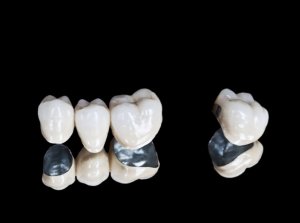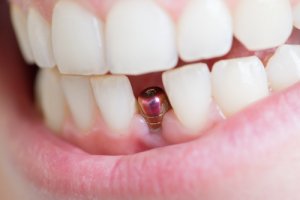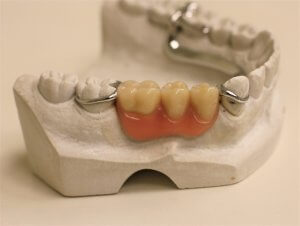Missing a tooth isn’t fun, and it’s important for your oral health to get that gap filled in. There are several restorative dentistry solutions available nowadays for replacing missing teeth, and in this article, we will focus on the dental bridge.
A bridge is a way of filling gaps between one or two teeth between two healthy teeth.
In this article, we’ll answer your questions about tooth bridges, including:
- What is a dental bridge?
- Dental bridge materials
- Types of dental bridges
- Can I get a dental bridge for front teeth?
- What’s the difference between a bridge, implant, and denture?
- How much does a tooth bridge cost in the US?
- Dental bridge problems
- Dental bridge replacement
We have made this guide to teeth bridges as comprehensive as possible so you can find all the information you need in one place. We’ve also provided plenty of dental bridge pictures so you know what to expect from your new smile. We hope this helps you decide whether a bridge is the best option for you.
What is a dental bridge?
Before we begin —
Did you know that many insurance plans cover this treatment? We’ve created this easy-to-use insurance comparison tool! Just enter your DOB and zipcode, and in seconds you’ll see the best plans in your area.


A dental bridge is a type of dental prosthesis that literally bridges the gap between two teeth. If you have lost one or two teeth to decay or because of an accident, a bridge can make your smile complete again.
Where more than two teeth in a row are missing, an implant-supported bridge may be an option – more on those later.
Dental bridge materials
Tooth bridges come in a variety of materials and finishes. Here’s a quick look at the advantages and disadvantages of each:
Metal only
Metal alloys are usually the cheapest option, but they have the obvious disadvantage of looking nothing like natural teeth. If the retainer and pontic won’t be too visible when you smile, a metal tooth bridge could be a good choice.
Ceramic only
Porcelain, ceramic, and zirconium bridges, when made well, look exactly like natural teeth. They are, therefore, the preferred materials for a front tooth bridge. However, they come at a much higher cost because of the materials and lab work involved. CAD/CAM dental technology is sometimes used to create bridges.
When first introduced, ceramic bridges suffered from a lack of durability. But thanks to modern technology and materials used in dentistry, they have become much stronger, making options like Emax crowns a popular choice.
Porcelain fused to metal (PFM)


A solution that balances cost with appearance is a bridge made from ceramic or porcelain fused to a metal base (as pictured). This type of bridge can lose its aesthetic appearance over time as the ceramic thins and exposes the metal underneath.
A PFM bridge also may not be as strong as pure ceramic. The best material for your dental restoration will depend on your budget and the position of your missing teeth.
Types of dental bridges
Traditional tooth bridges use the adjacent teeth as anchors for the prosthesis. There are two ways to fit a bridge to the existing teeth: fixed or bonded.
Fixed bridge
A fixed bridge is the most common type of dental bridge as it provides a strong, durable way to replace one or two adjacent teeth.
The prosthesis used for a fixed bridge consists of a crown on either side and one or two pontics (artificial teeth) in the middle. The crowns are hollow and fit over the neighboring teeth to secure the bridge in place.
In order for the crowns to fit properly, the anchor teeth must be filed down from their original size as part of the dental bridge procedure. These two teeth have to be strong enough to support the bridge and take the extra biting pressure. Dentists may perform root canal treatment on the anchor teeth before removing the necessary amount of enamel.
After preparing the anchor teeth, the next step in the dental bridge procedure is to take a dental impression. This is sent to a dental laboratory where your bridge is precisely made to measure. In the meantime, your dentist may provide a temporary bridge to protect the exposed teeth and gums.
Once your permanent bridge is ready, your dentist will position it in your mouth and ask you to test how it feels. Provided you’re happy with the fit, your dentist will fix it in place using strong dental cement. Further visits are sometimes required to improve the fit, but not always.
The main drawback to a fixed dental bridge is having to ‘sacrifice’ two healthy teeth. If you later decide to replace your bridge with an implant, the adjacent teeth will require dental crowns since the removal of enamel is permanent.
You’ll also need to take special care with dental bridge cleaning and flossing. Using a water flosser can make the process quicker, easier, and more effective. If that sounds interesting to you, you can read more about the best water flossers.
Dental bridge cleaning requires many of the same steps as cleaning implant-supported dentures, like All-on-4s. You can find out more tips and tricks for cleaning them in our article on how to clean All-on-4 dental implants.
Aside from that, a fixed bridge is a strong and durable solution. If you opt for a ceramic or porcelain bridge, nobody should be able to spot that the teeth aren’t natural.
If you have lost one or more teeth, you have likely noticed a negative effect on the function, appearance, and health of your smile. It may be more difficult to speak, chew, and eat as normal, and you may feel embarrassed about your smile because of the gaps left by missing teeth.
To replace your missing teeth and restore your smile and self-confidence, your dentist may recommend a dental bridge. A bridge is used to replace one missing tooth or a couple of missing teeth in a row. When in place, a bridge can improve your smile by:
- Restoring the natural shape and volume of your face
- Improving your ability to properly chew, speak, and eat
- Enhancing the beauty of your smile
- Preventing the remaining teeth from moving into the space left by the missing teeth
- Relieving uneven stress on the bite
- Replacing an unwanted removable partial denture (removable dental bridge)
Dr. Robert Berry, Mountain Aire Dentistry
Front teeth bridge
A dental bridge for front teeth may require two crowns on either side since the biting pressure on the front incisors is so great.
If you are missing one or more front teeth or have been told you need to get a tooth extraction, your dentist will be able to advise you on the best type of front tooth bridge for you.
Bonded bridge
When there is only one tooth to replace, your dentist may fit a resin-bonded bridge (also called a Maryland bridge).
Rather than being fitted over the adjacent teeth with crowns, this type of bridge has metal or porcelain ‘wings’ on each side which are bonded to the inner edge of the adjacent teeth.
A bonded bridge, of course, has the advantage of preserving the healthy adjacent teeth. The main downside is that it won’t be as strong as a fixed bridge. Over time the dental glue holding it in place can weaken, causing the bridge to break off or become loose.
With any type of bridge for teeth, it is only the crown of the tooth that is being replaced. The root remains absent, and this can cause the jawbone to recede over time.
Long-term, this may cause sagging around the face. If you choose to have implants at a later date, you may first need a bone graft. This is really the main problem with a dental bridge that patients need to be aware of.
Dental bridge vs. implant vs. denture
Teeth bridges, implants, and dentures are all dental solutions for the replacement of missing teeth. Each offers advantages and disadvantages over the others, which we have summarized below. However, the best way to determine which is right for you is to have a consultation with your dentist. Be sure to also check out our article on getting dentures vs implants.
Teeth implants


Dental implants are placed directly into your jawbone, where your tooth root would have been. They are usually made from titanium, a very strong material that is biocompatible with our bodies (meaning there should be no allergic reaction or rejection of the implant).
An abutment is fitted to the implant, and this is what holds the crown (the replacement tooth) in place.
The main benefits of implants over bridges are:
- They don’t affect the adjacent teeth
- They are a more durable solution and can last a lifetime
- It’s easier to maintain good oral hygiene with an implant (less chance of decay and gum disease)
- They help maintain the structure of the jawbone and the shape of the face
On the downside, implants require some surgery and are much more expensive than a bridge fitted over teeth. If you take into account the lifetime cost and inconvenience of replacing your bridge, though, an implant may work out as a good investment in the long run.
Treatment time is another consideration for some patients. The process for placing a traditional implant takes several months, as the implant needs time to settle and fuse with the bone before the abutment and crown are attached. For some patients, this is just too long to wait, so a bridge is the better solution.
If you are missing a tooth because of trauma, you may need additional time to heal before the implant process commences.
Implant-supported bridges
For patients who are missing several teeth in a row or whose remaining teeth aren’t healthy enough to be used as anchors, an implant bridge may be an option. Dentists can install implants in place of anchor teeth and then fit a bridge (made from two crowns and one or two pontics) over them.
This option is more cost-effective than replacing each tooth with an individual implant since it uses fewer implants.
Dentures
Dentures are what most people think of as ‘false teeth‘. They consist of one or more prosthetic teeth fixed to a frame made from plastic and metal, which clips around existing teeth. The versatility of false teeth means they can be made to fit around any number of remaining healthy teeth. People who have lost all their teeth can get a full set of dentures.


Although partial dentures are the most affordable option when it comes to replacing a missing tooth, they are also the least convenient to live with. Wearers must be careful about what they eat as certain foods will dislodge or damage dentures.
Because of the way our mouths change over time (especially when teeth are missing), dentures may only last for a few years before coming loose. If they are not replaced, they can become uncomfortable and cause mouth sores. There is also a chance of them slipping out mid-conversation.
Comparing the options
Below is a comparison table for the tooth replacement options described above:
Dental bridge | Dental implant and crown | Denture | |
Permanency | Fixed to adjacent teeth; non-removable | Implanted in the jaw bone, fixed in place | Removable |
Longeity | 5-15 years, possibly longer | 20+ years | 5-10 years, possibly longer |
Comfort | Like natural teeth if fitted well | Like natural teeth | May become loose over time and cause discomfort |
Appearance | Like natural teeth | Like natural teeth | May look artificial; metal clips may be visible |
Function | Like natural teeth | Like natural teeth | Certain foods must be avoieded; remove to clean |
Cost | Medium | High | Low |
Other pros/cons | Requires removal of enamel on neighboring teeth | Involves surgery; small risk of infection | Can slip out of place; easy to lose or damage while removed |
The animation below shows the process for fitting a 3-unit bridge compared to a single-tooth implant
Keep in mind that any kind of artificial tooth or tooth covering will be unaffected by teeth whitening. It’s important to remember this if you have a bridge that is visible when you smile.
How much does a dental bridge cost?
Dental bridge costs are, on average, $500 to $1,500 for a traditional fixed crown and bridge and as much as $2,300 for a bonded bridge. The costs depend on the materials and your dentist.
How much does an implant-supported bridge cost?
The best kind of bridge is an implant-supported bridge, but this is also the most expensive option. Implant-supported bridge costs start at $5,000, which is too much for most to pay out of pocket.
3 Ways To Finance Dental Work That Aren’t Insurance
How much does a 3-tooth implant bridge cost?
A 3-unit tooth implant bridge can cost anywhere from $500 to $1,500 for a standard model. However, if you want a 3-tooth implant bridge secured by an implant, costs could start at $5,000.
How much does a dental bridge cost with insurance?
If you need a bridge but can’t afford one, you may be able to find dental insurance that covers bridges. There are even plans that cover up to 50% of treatment.
We know that dental insurance can be expensive and it can also be difficult to know which plan to choose.
But we are here for you — we’ve created a special comparison tool that shows you the top plans in your area to help guide you in your decision.
It takes just a few seconds to fill in your DOB and zip code, and you’ll see full coverage plans that cover your needs. Get started with the form below!


Other tooth bridge cost factors
Your bridge cost will also depend on the material used and the type of bridge chosen, as well as your dentist’s fees for consultations, fitting, etc. Your local clinic can probably give you an idea of prices prior to a consultation, either by phone or on their website. Keep in mind that the three-unit bridge cost will be more than a two-unit, and a two-unit more than a bridge for just one tooth.
Your dentist will certainly want to check your mouth and the state of your remaining teeth before confirming your treatment plan and providing a final dental bridge cost estimate.
If you have a dental plan, it may well offer you a discount on restorative treatment with a bridge. Some plans even make a contribution towards the cost of implants.
You’ll need to visit a dentist to get a quotation for your treatment, but this table shows the approximate dental bridge repair cost:
Type of bridge | Average cost |
Traditional fixed crown and bridge | $500 – $1,500 per unit |
Bonded bridge | $700 – $2,300 |
Implant-supported bridge (2 implants, 3-unit bridge) | From $5,000 |
You could also consider traveling overseas for dental tourism to get cheaper dental bridges. Costa Rica and Mexico are two of the most popular destinations for Americans seeking more affordable treatment.
You can also read our finance article for more dental financing options.
Dental bridge problems
Although teeth bridges are a great way to replace missing teeth, of course, complications can occur – just like with any kind of dental treatment. If you’re worried about dental bridge risks, here are some of the most common problems with dental bridges that you might encounter.
Infection under dental bridge
There are three main causes of infection under and around a tooth bridge:
- Poor oral hygiene
- A poorly fitting bridge irritates the gum
- Decay in the supporting teeth
When you first get your tooth bridge fitted, your dentist will advise you how to clean under a dental bridge, as well as on the surfaces. Following this advice will help you avoid complications with infection in the surrounding teeth. If you think your dental bridge is infected, visit your dentist before it develops into something more serious, like an oral abscess.
Sensitivity under dental bridge
Your mouth and gums need to get used to the shape of your new teeth, so it’s normal to feel some sensitivity around your teeth and gums for a few days after having a dental bridge placed. This is especially true if you had root canal treatment as well.
If sensitivity continues for more than a couple of weeks, it may be due to a problem with the placement of the tooth bridge. It’s best to visit your dentist so they can assess the situation. Also, see your dentist if you start experiencing sensitivity or pain under an old dental bridge.
Food caught under dental bridge
You will need to take extra care when cleaning around your dental bridge since food can get stuck in the small spaces between the pontic and gum. Not only is this uncomfortable; it will soon start to smell bad and breed bacteria that cause decay.
Using a water flosser will help you dislodge any food caught under your dental bridge. The cariPRO water flosser, for example, is gentle yet effective at cleaning around teeth bridges, and crowns.
Metal appearing at the base of teeth
One of the downsides of porcelain fused to metal (PFM) bridge is that, over time, the porcelain can wear away to reveal a line of metal at the gum line. This is not necessarily a sign that there is something wrong with the bridge, but it can be unsightly, especially with a dental bridge for front teeth.
Your dentist can advise you of the best course of action, depending on the overall condition of your bridge. If you want to avoid this problem, opt for an all-ceramic tooth bridge instead of one that contains metal.
Dental bridge feels tight


It will take you some time to get used to the feel of your new tooth bridge. It may feel tight – even painful – at first because there is extra pressure on the supporting teeth. If this feeling doesn’t settle down after a week or so, feel free to mention it to your dentist.
Dental bridge can feel loose
If your dental bridge feels loose straight after it’s been fitted, your dentist will need to re-cement it. If you feel your tooth bridge moving around, book an appointment straight away so it can be fixed before any damage occurs.
Over time, the dental cement that holds a tooth bridge in place will start to fail and this may cause an old bridge to feel loose or even fall off. It may be possible to re-cement it if the supporting teeth are still in good condition; otherwise, it will have to be replaced.
How to fix a loose dental bridge at home
You can buy dental bridge repair glue online like this glass ionomer luting cement. Follow the instructions carefully and it might be enough to keep a bridge or crown in place for several months.
One customer shares her experience with this product: “My bridge came off the day after Dentists closed for lockdown. Not knowing how long it would last, I decided to take the situation into my own hands. Thank goodness I did! The kit is very straightforward and easy to use. The bridge hasn’t moved since replacing it. Very pleased with the results.”
Using dental glue to fix your bridge at home is rarely as effective as getting it treated professionally. Only use this as a temporary dental bridge solution while you’re waiting to see your dentist.
What should I do if I swallowed my dental bridge?
If a tooth bridge becomes dislodged while you’re eating or sleeping, you may accidentally swallow it. Don’t worry – you’re certainly not the first to do this, and it’s easily resolved.
Many people who swallow a tooth bridge find that it passes naturally without any problems. However, it’s best to visit your doctor, especially if nothing has emerged after 2-3 days because it can get caught in your digestive system and lead to more serious problems.


Dental bridge replacement
Most people with dental bridges will need replacement within a decade or so. Let’s look at some of the most common questions people have when it comes to replacing a dental bridge. Dental bridges can last 10 to 15 years or more. Over time, however, the materials will begin to deteriorate, at which point your dentist will replace your bridge.
This study of 80,000 patients found that 72% of conventional dental bridge abutments survived the past 10 years, which is about the same survival rate as dental crowns. After this time, the materials begin to deteriorate and the supporting teeth are at greater risk of decay. Your dentist will check your bridge at your dental checkups and will let you know when it needs to be replaced.
The cost of dental bridge replacement can add up over the years, so you might consider making an investment in dental implants instead. Implants last much longer – possibly for a lifetime – so they can be more cost-effective in the long run.
Conclusion
Both dentures and bridges for teeth are relatively affordable and may be covered by insurance, so getting a prosthetic tooth doesn’t need to break the bank. For those who want a natural-looking, permanent way to fill a gap between teeth, a bridge may be the best option. Once fitted, you can forget that it isn’t one of your natural teeth.
Implants are an even longer-lasting solution and they help retain the patient’s jaw bone and facial shape. However, they cost a lot more than bridges. Fortunately, there are ways you can save money on cheap dental implants if this is the option you wish to choose.
FAQs
Can you remove a dental bridge?
No, a dental bridge is designed to be fixed in place permanently. Dentures, on the other hand, can be removed. If your dental bridge has a poor fit, your dentist may be able to remove it. Then they can re-cement it for a better fit.
How much does a dental bridge cost without insurance?
A dental bridge cost without insurance is between $500 to $1,500. However, note that different factors affect how much money you can expect to pay for a dental bridge on average. For example, the cost of the bridge can be influenced by the material used as well as the condition of the teeth.
How long does it take to get a dental bridge?
You’ll need at least two appointments with your dentist and a week or two to make the tooth bridge itself. However, some dentists may have access to technology which makes this much quicker. If it’s important you get your new false tooth bridge quickly, check with a few dentists about their processing time.
How long does it take for a dental bridge to settle?
Your new dental bridge may feel strange for a few days or even weeks as your mouth gets used to it. During this time, you might experience sensitive teeth and gums.
If you’re experiencing severe pain or your bridge is affecting your natural bite, mention it to your dentist.
How much is a dental bridge?
The average cost for dental bridge tooth replacement is between $500 and $1,500. However, they can cost up to $2,300 for a bonded bridge and implant-supported bridge costs start at $5,000.
How long does it take to get used to a dental bridge?
For most patients, it can take a couple of weeks to adjust to a new bridge. During this time, it’s recommended to stay away from hot and cold or hard foods and use toothpaste for sensitive teeth.
Can a dental bridge be removed and recemented?
Yes, in some cases, your dentist may be able to remove your bridge and recement it if it is a poor fit or has become loose. Only your dentist can do this, so don’t try to do this at home.
Can a dental bridge be removed and reused?
In some cases, yes. Your dentist may be able to remove your bridge if necessary and reuse it. However, this may not always be the case, and bridge removal could damage the bridge.
NCBI: Ten year survival of bridges placed in the General Dental Services in England and Wales. Consulted 25th November 2020.




